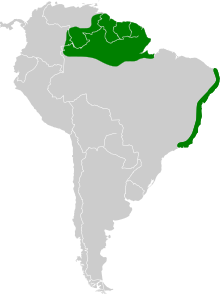Racket-tailed coquette
| Racket-tailed coquette | |
|---|---|

| |
| A male in Pernambuco, Brazil, spreading its tail | |
| Scientific classification | |
| Domain: | Eukaryota |
| Kingdom: | Animalia |
| Phylum: | Chordata |
| Class: | Aves |
| Clade: | Strisores |
| Order: | Apodiformes |
| Family: | Trochilidae |
| Genus: | Discosura |
| Species: | D. longicaudus
|
| Binomial name | |
| Discosura longicaudus (Gmelin, JF, 1788)
| |

| |
| Range of the racket-tailed coquette | |
| Synonyms[3] | |
|
Discosura longicauda (Gmelin, 1788) | |
The racket-tailed coquette (Discosura longicaudus; sometimes Discosura longicauda) is a species of
Taxonomy
The racket-tailed coquette was

It is sometimes considered to be the only member of the genus Discosura, as the thorntails, the other possible members of the genus, are often placed in the genus Popelairia.[12][13]
Martin Johnson Heade depicted two coquettes in his painting Two Green-Breasted Hummingbirds (c. 1863), as part of his "Gems of Brazil".[14]
Description
The species weighs about 3.4 grams (0.12 oz) and is sexually dimorphic. The male is around 10.2 centimetres (4.0 in) long and has a distinctive brilliant green head and throat with a copper-coloured abdomen. The dark purple-brown tail is 5.1 centimetres (2.0 in) long, and forked, with two very long prongs, ending with a pair of round paddle- ("racket") shaped feathers. The female is shorter with a length of 6.9 centimetres (2.7 in). It has duller green upperparts and breast, black throat bordered by white and a white belly. Its tail is grey tipped with white,[15] and lacks "rackets".[16]
Distribution and habitat
The racket-tailed coquette generally is uncommon but it has a large distribution that is separated into two distinct parts: The largest is in the
Behavior
Racket-tailed coquettes typically gather in the
They build their cup-sized nests out of soft plants and
References
- . Retrieved 11 November 2021.
- ^ "Appendices | CITES". cites.org. Retrieved 2022-01-14.
- ^ "Discosura longicaudus (Gmelin, 1788)". Colaboraciones Americanas Sobre Aves. Retrieved 23 February 2013.
- ^ Gmelin, Johann Friedrich (1788). Systema naturae per regna tria naturae : secundum classes, ordines, genera, species, cum characteribus, differentiis, synonymis, locis (in Latin). Vol. 1, Part 1 (13th ed.). Lipsiae [Leipzig]: Georg. Emanuel. Beer. p. 498.
- ^ Buffon, Georges-Louis Leclerc de (1779). "L'oiseau-mouche à raquettes". Histoire Naturelle des Oiseaux (in French). Vol. 6. Paris: De l'Imprimerie Royale. pp. 23–24.
- ^ Berlepsch, Hans von; Hartert, Ernst (1902). "On the birds of the Orinoco region". Novitates Zoologicae. 9: 1–135 [89].
- ^ Peters, James Lee, ed. (1945). Check-List of Birds of the World. Vol. 5. Cambridge, Massachusetts: Harvard University Press. p. 35.
- ^ Bonaparte, Charles Lucien (1850). Conspectus Generum Avium (in Latin). Vol. 1. Leiden: E.J. Brill. p. 84.
- ^ Rasmussen, Pamela, eds. (January 2022). "Hummingbirds". IOC World Bird List Version 12.1. International Ornithologists' Union. Retrieved 12 July 2022.
- ^ David, Norman; Gosselin, Michel (2002). "Gender agreement of avian species names". Bulletin of the British Ornithologists' Club. 122 (1): 14–49 [37, No. 161, 47].
- ISBN 978-1-4081-2501-4.
- ^ a b "Racket-tailed Coquette (Discosura longicauda)". The Internet Bird Collection. Retrieved 21 February 2013.
- ^ a b Sedgwick, Carolyn W. (2011). T. S. Schulenberg (ed.). "Discosura longicaudus". Neotropical Birds. Cornell Lab of Ornithology. Retrieved 26 February 2013.
- ISBN 978-0-300-08183-1. Retrieved 25 February 2013.
- ^ ISBN 1400834090.
- ^ a b "Racket-tailed Coquette (Discosura longicaudus)". Planetofbirds.com. 8 May 2011. Retrieved 26 February 2013.

